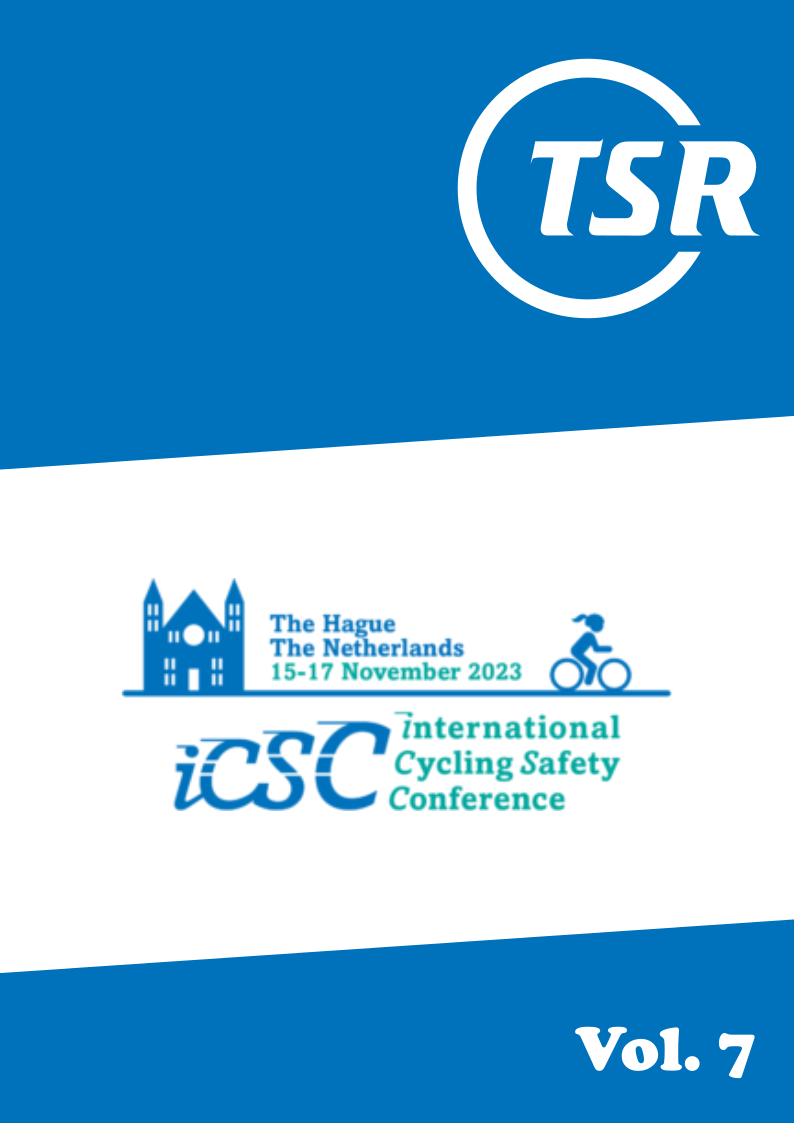How smooth is your ride? Comparison of sensors and methods for surface quality assessment using IMUs
DOI:
https://doi.org/10.55329/guai2275Keywords:
cycling comfort, inertial measurement unit (IMU), infrastructure assessment, sensor bike, surface roughnessAbstract
As a major component of riding comfort, surface roughness has a significant impact on peoples' decision to ride bicycles. Riding comfort is most commonly derived from accelerations measured by inertial measurement units (IMUs). However, roughness metrics from different works are not directly comparable as no ‘benchmark data’ exists. This work aims at alleviating this problem by comparing several well-established methods from literature on the same data. Furthermore, to quantify the effect of different sensor systems, for each test run data from both a smartphone and an industrial grade IMU were collected. To compare the derived roughness measurements, the reliability and stability of each sensor-method combination is calculated using non-parametric statistics. The results indicate handlebar mounted smartphones to be sufficient for surface roughness assessment. Furthermore, the selected roughness calculation method has the biggest impact on resulting assessments, above the impacts of both sensor and analyzed segment length. Based on the results, recommendations for surface roughness assessment are provided in the conclusion.
Downloads
References
Arthur, D., S. Vassilvitskii (2007), 'K-Means++ the Advantages of Careful Seeding', ACM-SIAM symposium on Discrete algorithms, New Orleans, LA, USA, 7–9 January 2007.
Astarita, V., V. Rosolino, I. Teresa, G. Vincenzo, D. M. Francesco (2014), 'Automated Sensing System for Monitoring of Road Surface Quality by Mobile Devices', Procedia - Social and Behavioral Sciences, 111. DOI: https://doi.org/10.1016/j.sbspro.2014.01.057
Axhausen, W. K., R. L. Smith (1986), 'Bicyclist Link Evaluation: A Stated-Preference Approach', Transportation Research Record, 1085.
Ayachi, F., J. Dorey, C. Guastavino (2014), 'Identifying Factors of Bicycle Comfort: An Online Survey with Enthusiast Cyclists', Applied Ergonomics, 46, 124. DOI: https://doi.org/10.1016/j.apergo.2014.07.010
Bíl, M., R. Andrášik, J. Kubecek (2015), 'How Comfortable Are Your Cycling Tracks? A New Method for Objective Bicycle Vibration Measurement', Transportation Research Part C: Emerging Technologies, 56. DOI: https://doi.org/10.1016/j.trc.2015.05.007
Blair, J., M. G. Lacy (2000), 'Statistics of Ordinal Variation', Sociological Methods & Research, 28(3). DOI: https://doi.org/10.1177/0049124100028003001
Calvey, J., J. P. Shackleton, M. D. Taylor, R. Llewellyn (2015), 'Engineering Condition Assessment of Cycling Infrastructure: Cyclists’ Perceptions of Satisfaction and Comfort', Transportation Research Part A: Policy and Practice, 78. DOI: https://doi.org/10.1016/j.tra.2015.04.031
Castañon, U. N., P. J. G. Ribeiro (2021), 'Bikeability and Emerging Phenomena in Cycling: Exploratory Analysis and Review', Sustainability, 13(4). DOI: https://doi.org/10.3390/su13042394
Corder, G. W., D. I. Foreman (2014), Nonparametric Statistics: A Step-by-Step Approach, (New Jersey, USA: John Wiley & Sons).
CROW, (2016), 'Design Manual for Bicycle Traffic', (Rotterdam, the Netherlands: CROW-fietsberaad). Record 28.
EC, (2023), 'Communication from the Commission to the European Parliament, the Council, the European Economic and Social Committee and the Committee of the Regions. Proposing a European Declaration on Cycling', Brussels, 4.10.2023 COM(2023) 566 final.
Gadsby, A., J. Tsai, K. Watkins (2022), 'Understanding the Influence of Pavement Conditions on Cyclists’ Perception of Safety and Comfort Using Surveys and Eye Tracking', Transportation Research Record: Journal of the Transportation Research Board, 2676(12). DOI: https://doi.org/10.1177/03611981221090936
Gadsby, A., K. Watkins (2020), 'Instrumented Bikes and Their Use in Studies on Transportation Behaviour, Safety, and Maintenance', Transport Reviews, 40(6). DOI: https://doi.org/10.1080/01441647.2020.1769227
Gao, J., A. Sha, Y. Huang, H. Liqun, Z. Tong, W. Jiang (2018), 'Evaluating the Cycling Comfort on Urban Roads Based on Cyclists’ Perception of Vibration', Journal of Cleaner Production, 192. DOI: https://doi.org/10.1016/j.jclepro.2018.04.275
Harikrishnan, P. M., V. Gopi (2017), 'Vehicle Vibration Signal Processing for Road Surface Monitoring', IEEE Sensors Journal, 17(16). DOI: https://doi.org/10.1109/JSEN.2017.2719865
Hoelzel, C., F. Höchtl, V. Senner (2012), 'Cycling Comfort on Different Road Surfaces', Procedia Engineering, 34. DOI: https://doi.org/10.1016/j.proeng.2012.04.082
Holger, H., N. Ibesich, A. Kurzweil (2015), 'Cycling Master Plan 2015 - 2025', Federal Ministry of Agriculture, Forestry, Environment and Water Management.
ISO, (1997), 'Mechanical vibration and shock — Evaluation of human exposure to whole-body vibration', International Standards Organisation, ISO 2631-1:1997.
Kranzinger, S., S. Leitinger (2021), 'Eine Bestimmung der Oberflächenqualität von Fahrradinfrastruktur durch Smartphone-Beschleunigungsdaten mithilfe des k-means++-Algorithmus [A Determination of the Surface Quality of Bicycle Infrastructure from Smartphone Acceleration Data Using the k-means]', Journal für Angewandte Geoinformatik, 7.
Landis, B. W., V. R. Vattikuti, M. T. Brannick (1997), 'Real-Time Human Perceptions: Toward a Bicycle Level of Service', Transportation Research Record, 1578(1), 119–126. DOI: https://doi.org/10.3141/1578-15
Litzenberger, S., T. Christensen, O. Hofstätter, A. Sabo (2018), 'Prediction of Road Surface Quality during Cycling Using Smartphone Accelerometer Data', Proceedings, 2(6), 217. DOI: https://doi.org/10.3390/proceedings2060217
Neto, V. A. G., J. D. F. Viana, R. B. Braga, C. T. Oliveira (2018), 'Surfaces Categorization Based on Data Collected by Bike Sensors', Euro American Conference on Telematics and Information Systems, Fortaleza, Brazil, 12–15 November 2018. DOI: https://doi.org/10.1145/3293614.3293625
Nuñez, J. Y. M., D. R. Bisconsini, A. N. R. da Silva (2020), 'Combining environmental quality assessment of bicycle infrastructures with vertical acceleration measurements', Transportation Research Part A: Policy and Practice, 137, 447–458. DOI: https://doi.org/10.1016/j.tra.2018.10.032
Olieman, M., R. Marin-Perianu, M. Marin-Perianu (2012), 'Measurement of Dynamic Comfort in Cycling Using Wireless Acceleration Sensors', Procedia Engineering, 34. DOI: https://doi.org/10.1016/j.proeng.2012.04.097
ÖVDAT, (2022), 'Die Graphenintegrations Plattform GIP. Das Referenzsystem der öffentlichen Hand für Verkehrsinfrastrukturdaten [The graph integration platform GIP. The public sector reference system for transport infrastructure data]', Österreichisches Institut für Verkehrsdateninfrastruktur.
Rehrl, K., S. Gröchenig, M. Wimmer (2018), 'Optimization and Evaluation of a High-Performance Open-Source Map-Matching Implementation', in Mansourian, A., P. Pilesjö, L. Harrie, R. van Lammeren (eds.), Geospatial Technologies for All, (Cham, Switzerland: Springer). DOI: https://doi.org/10.1007/978-3-319-78208-9_13
Sayers, M. W., M. S. Karamihas (1998), The Little Book of Profiling, (USA: University of Michigan).
Taylor, M., C. A. Fairfield (2010), 'Intelli-Bike: A Cycling Infrastructure Asset Management System', Proceedings of the Bicycle and Motorcycle Dynamics 2010. Symposium on Dynamics and Control of Single Track Vehicles, Delft, The Netherlands, 20–22 October 2010.
UN, (2024), 'Cycling and Sustainable Development Goals', United Nations Regional Information Centre for Western Europe.
Wijerathne, N., S. K. Viswanath, M. S. Hasala, V. Beltran, C. Yuen, H. B. Lim (2018), 'Towards Comfortable Cycling: A Practical Approach to Monitor the Conditions in Cycling Paths', IEEE World Forum on Internet of Things, Singapore, 5–8 February 2018. DOI: https://doi.org/10.1109/WF-IoT.2018.8355173
Yamanaka, H., S. Namerikawa (2007), 'Measuring Level-of-Service for Cycling of Urban Streets Using ‘Probe Bicycle System’', Journal of the Eastern Asia Society for Transportation Studies, 7.
Yamanaka, H., P. Xiaodong, J. Sanada (2013), 'Evaluation Models for Cyclists’ Perception Using Probe Bicycle System', Journal of the Eastern Asia Society for Transportation Studies, 10.
Zang, K., J. Shen, H. Huang, M. Wan, J. Shi (2018), 'Assessing and Mapping of Road Surface Roughness Based on GPS and Accelerometer Sensors on Bicycle-Mounted Smartphones', Sensors, 18(3). DOI: https://doi.org/10.3390/s18030914
Published
How to Cite
Issue
Section
Categories
License
Copyright (c) 2024 Moritz Beeking, Hannah Wies, Markus Steinmaßl, Karl Rehrl

This work is licensed under a Creative Commons Attribution 4.0 International License.
Funding data
-
Bundesministerium für Klimaschutz, Umwelt, Energie, Mobilität, Innovation und Technologie
Grant numbers GZ 2021-0.641.557











